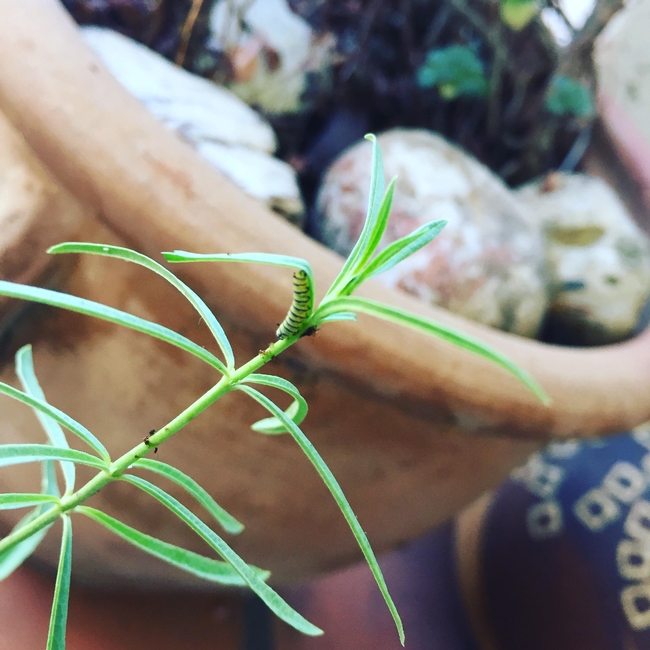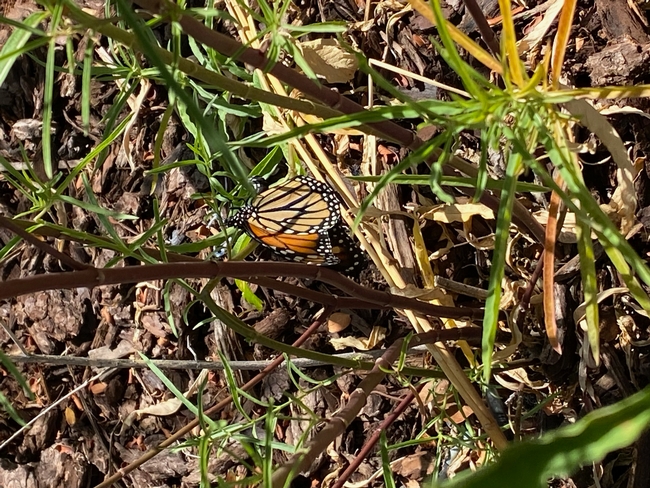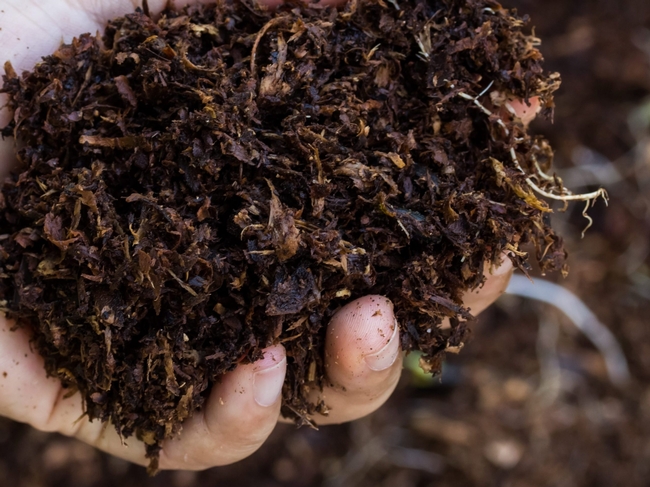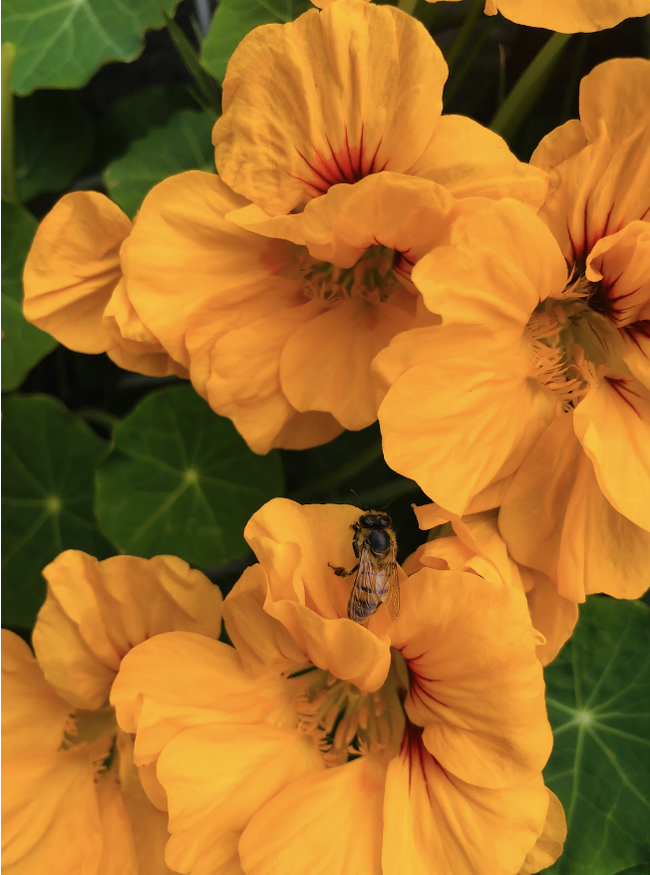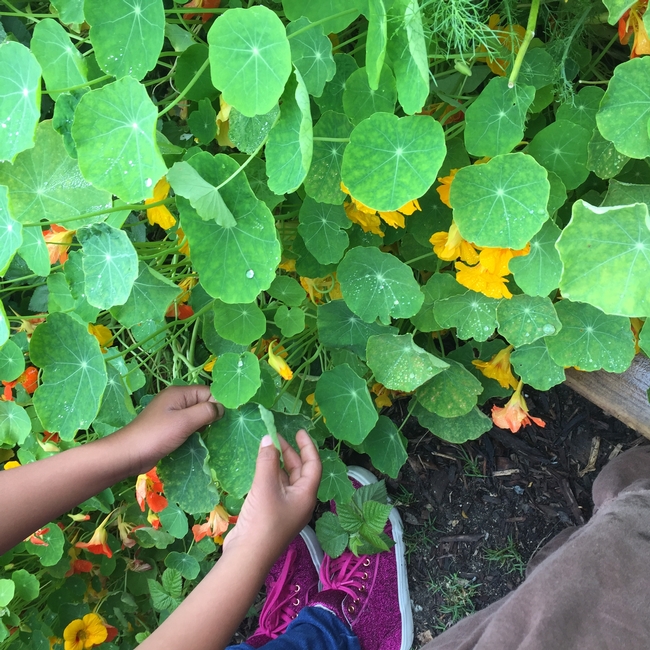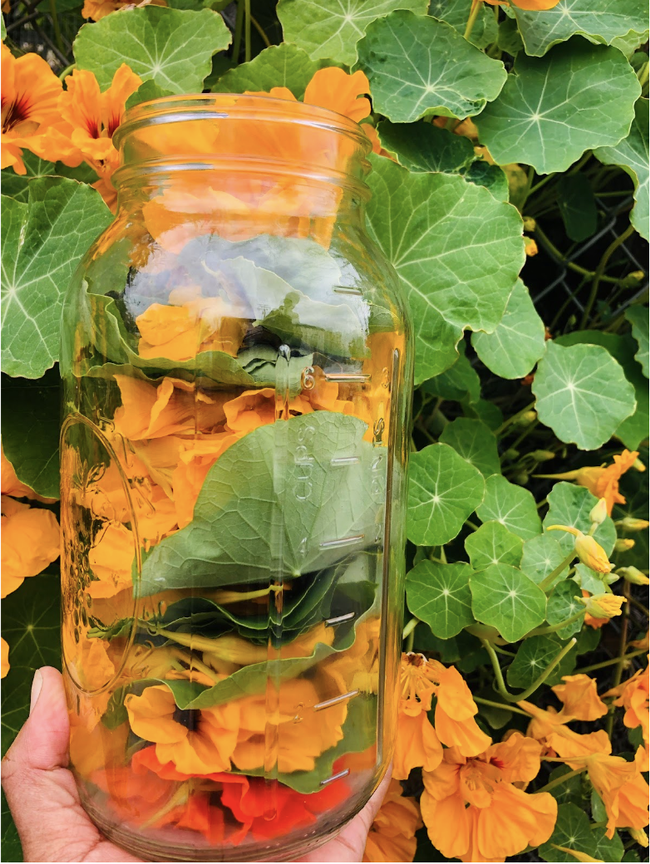- Author: Martin Saiz
- Author: Anna Judy de Torres
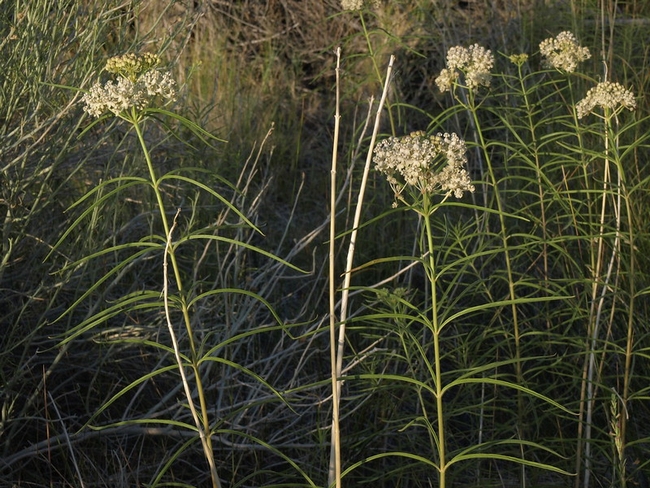
What is California's native milkweed and why should we plant it?
Native milkweeds are perennials with clusters of small (usually white or pink) flowers that grow in every eco-region of California. The native milkweeds are an important nectar source to a range of pollinators including bees, hummingbirds and butterflies. Native milkweeds go dormant during the winter and sprout anew during the spring.
Milkweed is especially well known for its importance to monarch butterflies, since they are the required host plant formonarch caterpillars. No milkweed means no monarchs. Land development and use of herbicides have dramatically reduced the presence of native milkweed by taking away the flatlands and meadow areas where the plant grows well. The monarch butterfly population has dramatically declined and the best way that gardeners can support the monarchs is by planting their necessary host plant - the milkweed - as well as other needed nectar plants and by avoiding the use of pesticides.
The Xerces Society lists 15 different native milkweeds to California but recommends that Narrowleaf Milkweed (Asclepias fascicularis) and Showy Milkweed (Asclepias speciosa) as the best species to plant due to their ability to grow in the widest range of conditions and the opportunity to buy them commercially.
Is native milkweed hard to grow?
Antonio Sanchez of the Rancho Sierra Vista native plant nursery says, “Of all the native milkweed species, Narrowleaf Milkweed is the easiest to grow. It is true that it is a little more difficult to grow than the very easy and showy tropical milkweed, but not by much. It is like the difference between growing spinach and watermelon, you just have to know where and when to plant it. If growing from seed, always start the seed in the warm months, from April to July. If
growing from live plants, always install from March-August. Water deeply and frequently the first year, once or twice a week. After the first year, plants normally thrive on twice a month waterings. Plants thrive in full sun, but tolerate part shade as well, and can be successfully grown in sandy or clay soils.”
Where can I buy it?
Unfortunately, buying native milkweeds is not as easy as a visit to your local outside box store. Many only sell tropical milkweed. You could certainly request it though! Ventura County has even taken the unprecedented step of banning the sale of tropical milkweed.
Most native plant nurseries and many independent nurseries will have narrowleaf milkweed for sale during its prime growing season, from March to August. You can search on the California Native Plant Society website Calscape.org to find nurseries in your area that carry one of the native milkweed species.
If I have tropical milkweed planted, what do you recommend?
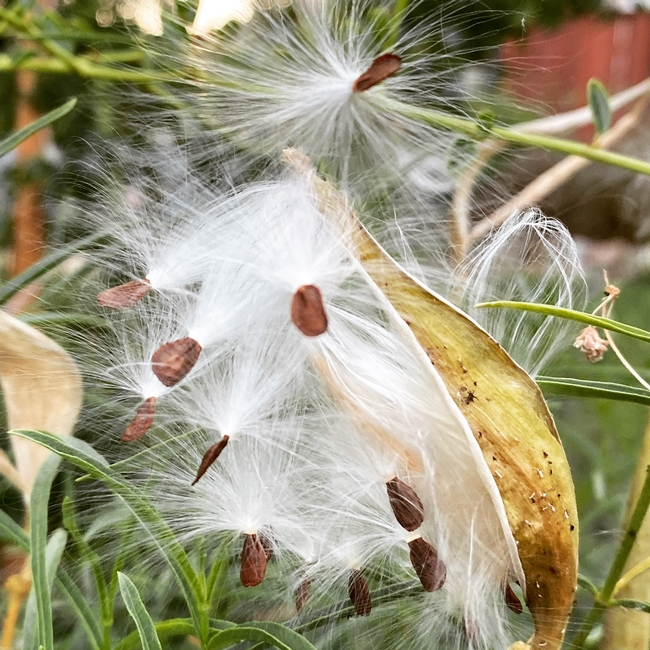
Most experts agree that if you have tropical milkweed planted, you should cut it down to the ground as winter approaches in order to mimic the growth patterns of native milkweeds and allow a healthier regeneration of the plant in the Spring.
The controversy over tropical vs. native milkweed stays strong in some gardening circles but native plant nursery manager Antonio Sanchez recommends the following, “If you have tropical milkweed in your garden, keep it going as you get your native milkweed patch established. The first year, cut back your tropical milkweed to the ground around Thanksgiving, and to the ground again around Valentine's Day. After one or 2 years, your native milkweed patch should become established, and you can then completely remove your tropical milkweed plants.”
What are the Los Angeles Master Gardeners doing to support the monarchs?
Los Angeles UC Master Gardener Martin Saiz collaborated with the native plant nursery at Rancho Sierra Vista to successfully request a major grant from the National Fish and Wildlife Fund (NFWF). The purpose of the grant is to address population declines and ensure the survival of the monarch butterfly. Over the next two years, the grant will fund gathering native milkweed seed from across the Santa Monica Mountains, propagating thousands of milkweed plants at the nursery, planting milkweed in 150 nearby acres, and establishing a network of milkweed way stations in 300 community, school, senior, and shelter gardens across Los Angeles County.
- Author: C.J. Crockett (MG ’21)
- Author: Christina Sergy
Soil, rather than dirt, is a living ecosystem that supports plant life. When soil is healthy and aerobic, it protects plants from disease, retains and gives access to nutrients, decomposes toxins, and builds soil structure.
One very important component of healthy soil is organic matter.
Soil scientists teach us that regular additions of organic matter, such as leaf litter, compost, mulch, worm castings, etc., contribute to making the soil that perfect loam that we all wish to attain. Organic matter attracts and feeds the crucial components of the soil food web. As it decomposes, it feeds fungi, bacteria, and nematodes. These in turn feed the next level of microorganisms, and on and on up the food chain. During this feeding frenzy, the byproducts produced are oxygen and essential nutrients that are now accessible by plants. Additionally, good soil structure is created in the process, allowing for air and water migration and then storage, thus allowing better access to the plant's root system.
How can you tell how healthy your soil is?
Look at it. Smell it. Touch it. Are there nice dark chunks of matter that crumble in your hand? Do you see worms? How about other signs of insect activity or tiny bright white feeder roots? Does it smell earthy? These are all signs of soil that's doing well. Conversely, if your soil is a dusty light brown and seems lifeless, or is black and smells putrid, these are definite signs that remediation is in order.
You may choose to have your soil tested to see its specific nutrient structure and amend accordingly. The truth is that by creating a healthy aerobic soil, you can help ensure that your plants get what they need to thrive. As it turns out, Mother Nature knew how to do it all along.
- Author: Christine Lai
"Sea of red... mulch, that is" by WSDOT is licensed under CC BY-NC-ND 2.0.
Benefits of Mulch
Mulch is one of the gardener's most useful tools: applied correctly, it suppresses weeds, improves water retention in soil, and keeps the soil temperature down. But does the kind of mulch matter? And do you tie up nitrogen when you use high carbon materials like wood chips as mulch?
Color matters
First of all, UC researcher Janet Hartin writes, don't use black dyed wood chips as mulch. Hartin, a resident of Coachella Valley, found that black dyed mulch, along with synthetic lawn and asphalt, can superheat surfaces up to 65 degrees hotter than the surfaces of plants in a study she conducted in the valley over the months May through August.
To till in or not?
Second, what about the carbon to nitrogen ratio of your mulch? This becomes an issue when mulch is tilled into the soil. Tilling in high carbon to nitrogen ratio materials like wood chips will tie up nitrogen in the soil leading to stunted plant growth. As the population and activity of the decomposers in the soil increase, they consume carbon and nitrogen, competing directly with garden plants for limited supplies of nitrogen. However, leaving mulch on top to slowly decay over time will not have this effect.
If you are tilling in your mulch, UC Riverside researchers (Pittenger 584) found that mixing in high nitrogen materials like grass clippings in with high carbon wood chips offset any temporary nitrogen tie up.
Tilling in green manures like alfalfa straw will supply nitrogen and has been found to be especially valuable to citrus trees.
Mulch and pests
Other things to consider when mulching are pests. UC Riverside researchers found that voles and gophers preferred trees with mulch. Pill bugs may find a home in leaf litter. Monitor plants and be sure to keep mulch away from stems.
A few notes on proper application
When applying mulch to trees, be sure to keep the mulch from touching the tree trunk and keep from piling too much on top of the root ball. Roots can grow up into the mulch and girdle the trunk. For other plants, keep mulch 4 to 6 inches away from stems. Apply 2 to 4 inches deep for maximum benefits.
Work Cited
Pittenger, Dennis R. California Master Gardener Handbook. Edited by Dennis R. Pittenger, University of California Division of Agriculture and Natural Resources, 2015.
- Author: Lynn Young
These jeweled toned beauties are wonderful in the garden.
Nasturtiums are quite easy to grow and usually planted in the Spring after the last frost has passed. I have seen Nasturtiums begin to grow from the previous season as early as January. Many believe they are perennials when in fact, they are annuals. There are so many varieties of Nasturtiums, my favorite being the trailing variety which I love to see climb walls, trellises, and fences. If you are without space, or have minimum garden space, Nasturtiums can be planted in a pot. Hanging pots are great for trailing Nasturtiums. They look amazing when they spill over the edges.
They grow full, flower vibrantly during the spring and early summer with jeweled tone colors, and have bright green leaves reminiscent of lily pads. Butterflies, bees and hummingbirds love this plant.
Nasturtiums grow best from seed sown directly in the soil. I have also propagated from cuttings that performed well in the garden.
Many gardeners plant Nasturtiums in the garden as a trap crop to draw away aphids from neighboring crops. Try planting Nasturtium next to cucumbers, kale and tomatoes for healthy company and natural pest control.
CARE
Nasturtiums do not need to be fertilized. In fact, fertilizer can produce more leaves than flowers. Developing a good weekly watering system should be sufficient. These beautiful blooms love full sun exposure and show tolerance for shade and some drought, although lack of water will cause flowers to wilt. When it comes to maintenance, trailing varieties can benefit from a light pruning and removal of yellowing leaves. Add the fresh green leaves to salad or enjoy a few pieces prior to discarding.
HARVEST
All parts of the nasturtium plant can be harvested for culinary use. The best time to harvest leaves is when the plant is young - approximately 6 inches tall. Harvest flowers just as they open. You can cut flowers and stems together. Collect the green seed pods when they are just over 1/4" inch in diameter. These can be used for pickling. Discard small, hardened pods.
Nasturtium seeds for future planting are easy to collect. The plants often self-sow. When they self-sow, the seeds fall to the ground, making collecting a breeze. Seeds will be a mixture of small and mature green and brown pods. I save the green pods for culinary use and collect the brown pods to grow for next season. Discard small, immature seeds, as they do not have a good germination success rate.
How to enjoy your Nasturtiums Leaves, Flowers and Seed Pods
All parts of Nasturtium plants are edible. The leaves, flowers and green seeds are used in cooking. The spicy leaves and flowers can be used fresh in salads. The green seed pods, which have a zesty tangy peppery flavor, have become known as “Poor Man's Capers.” I enjoy them fresh. There are so many culinary uses for fresh or pickled parts of the nasturtium plant. I have shared a use below.
Nasturtium Pickled Capers: 1-1-1
1 Cup of firm green seed pods
1 Cup of White Vinegar or Apple Cider
1 teaspoon of Sea Salt
8 Peppercorns
*Add a drizzle of honey for a sweet & tangy taste. Alllow the mixture to sit for 20 minutes or longer. Enjoy. Refrigerate whatever is left!
- Author: Sabrina Williams
Photos by Sabrina Williams
Soil is...
not dirt, of course. Many of us who have spent time in the garden know that dirt is essentially dead. Soil, on the other hand, is a living, complex ecosystem. As one of a triumvirate of life-giving elements — the other two being sun and rain — it has the power to sustain agricultural productivity and protect environmental resources. When you look at it up close, the world within it is reason enough to be impressed. In one cup of soil there are upwards of 200 billion bacteria, 20 million protozoa, 100,000 nematodes, and 100,000 meters of fungal hyphae! Sadly, human activity has contributed to the degradation of soil ecosystems, and consequently, a warmer, dirtier planet.
Soil Health Is…
also referred to as soil quality, and is defined as the continued capacity of soil to function as a vital living ecosystem that sustains plants, animals, and humans. According to the Soil Health Institute, a healthy soil provides many functions that support plant growth, including nutrient cycling, biological control of plant pests, and regulation of water and air supply.
Assessing how well soil performs its functions in the present, and its ability to do so in the future, can't be determined by any single result. Assessment relies upon many indicators. A “short” list offered by the folks at the USDA Natural Resources Conservation Service includes soil organic matter, soil structure, soil depth, water holding, habitat for soil microbes, tilth, reactive carbon, soil nitrate, soil pH, phosphorus and potassium, plant and microbial activity, earthworms, soil respiration, and total organic carbon.
Prioritizing Healthy Soil Is…
the best way to create resilient ecosystems. In doing so, we can reduce global food insecurity and environmental impacts of greenhouse gases. There is a lot of talk about CO2 (carbon dioxide) and its contribution to greenhouse gases. A powerful way to reduce CO2 in the atmosphere is to sequester it in our soils. Plants naturally help remove it through photosynthesis and sending the balance to the soil. So, not only does soil do the yeoman's work of retaining water and nutrients, but incredibly, it also sequesters carbon in excess of that retained by the sum of all plants and the atmosphere!
Importantly, healthy soil also feeds the world. It helps the 500-million smallholder farms globally who produce 80% of the world's food. According to the World Resources Institute, these farms will not be able to produce enough food for over 9 billion people without dramatic changes in how food is produced, including focuses on soil health and water management.
We are…
all stewards of the soil. The benefits of healthy soil don't just accrue to the small farms described above. Home gardens worldwide also can combat soil-depleting practices through crop diversity, proper fertilization, and no-till gardening. And, as more households in urban areas grow more at our homes, yards and urban gardens, we are altogether more productive per unit of area than are large producers.
We aren't often presented clear opportunities to have a hand in averting a point-of-no-return climate crisis. As growers, soil is…ours.


